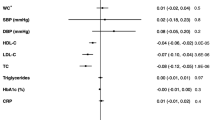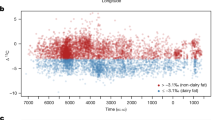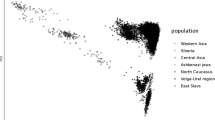Abstract
Lactase persistence is an autosomal-dominant trait that is common in European-derived populations. A basic tendency for lactase persistence to increase from the southeast to the northwest across European populations has been noted, but such trends within countries have not been extensively studied. We genotyped the C/T−13910 variant (rs4988235) that constitutes the putatively causal allele for lactase persistence (T allele representing persistence) in a general population sample of 3344 women aged 60–79 years from 23 towns across Britain. We found an overall frequency of 0.253 for the C (lactase non-persistence) allele, but with considerable gradients of decreasing frequency from the south to the north and from the east to the west of Britain for this allele. Daily sunlight was positively related to C (non-persistence) allele prevalence. However, sunlight exposure and latitude are strongly correlated, and it was not possible to identify which is the primary factor statistically underlying the distribution of lactase persistence. The C/T−13910 variant (rs4988235) was not related to drinking milk or bone health (although drinking milk itself was protective of bone health), and was essentially unrelated to a wide range of other lifestyle, health and demographic characteristics. One exception was general health being rated as being poor or fair, for which there was an odds ratio of 1.38 (1.04, 1.84) for women homozygous for the C allele; on adjustment for latitude and longitude of place of birth, this attenuated to 1.19 (0.87, 1.64). The lactase persistence variant could contribute to the examination of data for the existence of, and then statistical control for, population substructure in genetic association studies.
Similar content being viewed by others
Log in or create a free account to read this content
Gain free access to this article, as well as selected content from this journal and more on nature.com
or
References
Villako K, Maaroos H : Clinical picture of hypolactasia and lactose intolerance. Scand J Gastroenterol 1994; 29 (Suppl 202): 36–54.
Swallow DM, Hollox EJ : The genetic polymorphism of intestinal lactase activity in adult humans; in Scriver CR, Beaudet AL, Sly WS, Valle D (eds): The Metabolic and Molecular Basis of Inherited Disease. New York: McGraw-Hill, 2000, pp 1651–1662.
Kuokkanen M, Enattah NS, Oksanen A, Savilahti E, Orpana A, Jarvela I : Transcriptional regulation of the lactase–phlorizin hydrolase gene by polymorphisms associated with adult-type hypolactasia. Gut 2003; 52: 647–652.
Odling-Smee FJ, Laland KN, Feldman MW : Niche Construction: The Neglected Process in Evolution. Oxford: Princeton University Press, 2003.
Durham WH : Cultural mediation: the evolution of adult lactose absorption; in Durham WH (ed):: Co-evolution: Genes, Culture and Human Diversity. Stanford: Stanford University Press, 1991.
Bersaglieri T, Sabeti PC, Patterson N et al: Genetic signatures of strong recent positive selection at the lactase gene. Am J Hum Genet 2004; 74: 1111–1120.
Tishkoff SA, Reed FA, Ranciaro A et al: Convergent adaptation of human lactase persistence in Africa and Europe. Nat Genet 2007; 39: 31–39.
Enattah NS, Sahi T, Savilahti E, Terwilliger JD, Peltonen L, Jarvela I : Identification of a variant associated with adult-type hypolactasia. Nat Genet 2002; 30: 233–237.
Rasinperä H, Savilahti E, Enattah NS et al: A genetic test which can be used to diagnose adult-type hypolactasia in children. Gut 2004; 53: 1571–1576.
Poulter M, Hollox E, Harvey CB et al: The causal element for the lactase persistence/non persistence polymorphism is located in a 1Mb region of linkage disequilibrium in Europeans. Ann Hum Genet 2003; 67: 298–311.
Wacholder S, Rothman N, Caporaso N : Counterpoint: bias from population stratification is not a major threat to the validity of conclusions from epidemiological studies of common polymorphisms and cancer. Cancer Epidemiol Biomark Prev 2002; 11: 513–520.
Cardon LR, Palmer LJ : Wagging the dog? Population stratification and spurious allelic association. Lancet 2003; 361: 598–604.
Thomas DC, Witte JS : Point: population stratification: a problem for case–control studies of candidate–gene associations? Cancer Epidemiol Biomarkers Prev 2002; 11: 505–512.
Marchini J, Cardon LR, Phillips MS, Donnelly P : The effects of human population structure on large genetic association studies. Nat Genet 2004; 36: 512–517.
Freedman ML, Reich D, Penney KL et al: Assessing the impact of population stratification on genetic association studies. Nat Genet 2004; 36: 388–392.
Lawlor DA, Bedford C, Taylor M, Ebrahim S : Geographic variation in cardiovascular disease, risk factors and their control in older women: British Women's Heart and Health Study. J Epidemiol Commun Health 2003; 57: 134–140.
Lawlor DA, Ebrahim S, Davey Smith G : Socioeconomic position in childhood and adulthood and insulin resistance: cross sectional survey using data from the British women's heart and health study. BMJ 2002; 325: 805–807.
Ho MW, Povey S, Swallow D : Lactase polymorphism in adult British natives: estimating allele frequencies by enzyme assays in autopsy samples. Am J Hum Genet 1982; 34: 650–657.
Ferguson A, Macdonald DM, brydon WG : Prevalence of lactase deficiency in British adults. Gut 1984; 25: 163–167.
Iqbal TH, Wood GM, Lewis KO, Leek JP, Cooper BT : Prevalence of primary lactase deficiency in adult residents of west Birmingham. BMJ 1993; 306: 1303.
Rasinperä H, Forsblom C, Enattah NS et al: The C/C=13910 genotype of adult-type hypolactasia is associated with an increased risk of colorectal cancer in the Finnish population. Gut 2005; 54: 643–647.
Swallow DM : Genetics of lactase persistence and lactose intolerance. Annu Rev Genet 2003; 37: 197–219.
The Wellcome Trust Case Control Consortium: Genome-wide association study of 14,000 cases of seven common diseases and 3,000 shared controls. Nature 2007; 447: 661–678.
Campbell CD, Ogburn EL, Lunetta KL et al: Demonstrating stratification in a European American population. Nat Genet 2005; 37: 868–872.
Newcomer AD, Thomas PJ, McGill DB, Hofmann AF : Lactase deficiency: a common genetic trait of the American Indian. Gastroenterology 1977; 72: 234–237.
Hohkanen R, Pulkkinen P, Jarvinen R et al: Does lactose intolerance predispose to low bone density? A population-based study of permenopausal Finnish women. Bone 1996; 19: 23–28.
Obermayer-Pietsch BM, Bonelli CM, Walter DE et al: Genetic predisposition to adult lactose intolerance and relation to diet, bone density, and bone fractures. J Bone Miner Res 2004; 19: 42–47.
Horowitz M, Wishart J, Mundy L, Nordin BEC : Lactose and calcium absorption in postmenopausal osteoporosis. Arch Intern Med 1987; 147: 534–536.
Newcomer AD, Hodgson SF, Douglas MD, Thomas PJ : Lactase deficiency: prevalence in osteoporosis. Ann Intern Med 1978; 89: 218–220.
Rasinperä H, Savilahti E, Enattah NS et al: A genetic test which can be used to diagnose adult-type hypolactasia in children. Gut 2004; 53: 1571–1576.
Mainguet P, Faille I, Destrebecq L, Devogelaer J-P, Nagant de Deuxchaisnes C : Lactose intolerance, calcium intake, and osteopenia. Lancet 1991; 338: 1156–1157.
Obermayer-Pietsch BM, Gugatschka M, Reitter S et al: Adult-type hypolactasia and calcium availability: decreased calcium intake or impaired calcium absorption? Osteoporos Int 2007; 18: 445–451.
Stephenson LS, Latham MC : Lactose intolerance and milk consumption: the relation of tolerance to symptoms. Am J Clin Nutr 1974; 27: 296–303.
Corazza GR, Benati G, Di Sario A et al: Lactose intolerance and bone mass in postmenopausal Italian women. Br J Nutr 1995; 73: 479–487.
Harma M, Alhava E : Is lactose malabsorption a risk factor in fractures of the elderly? Annales Chirurgiae et Gynaecologiae 1988; 77: 180–183.
Matthews SB, Waud JP, Roberts AG, Campbell AK : Systematic lactose intolerance: a new perspective on an old problem. Postgrad Med J 2005; 81: 167–173.
Segall JJ : Milk and coronary heart disease mortality. J Epidemiol Community Health 2002; 56: 319.
Pereira MA, Jacobs Jr DR, van Horn L, Slattery ML, Kartashov AI, Ludwig DS : Dairy consumption, obesity, and the insulin resistance syndrome in young adults: the CARDIA Study. JAMA 2002; 287: 2081–2089.
Mennen LI, Lafay L, Peskena EJM, Novak M, Lepinay P, Balkau B : Possible protective effect of bread and dairy products on the risk of metabolic syndrome. Nutr Res 2000; 20: 335–347.
Massey LK : Dairy food consumption, blood pressure and stroke. J Nutr 2001; 131: 1875–1878.
Miller ER, Appel LJ, Riaby TH : Effects of dietary patterns on measures of lipid peroxidation. Circulation 2000; 102: 852–857.
Lawlor DA, Ebrahim S, Timpson N, Davey Smith G : Avoiding milk is associated with reduced risk of insulin resistance and the metabolic syndrome: findings from the British Women's Heart and Health Study. Diabet Med 2005; 22: 808–811.
Beja-Pereira A, Luikart G, England PR et al: Gene–culture coevolution between cattle milk protein genes and human lactase genes. Nat Genet 2003; 35: 311–313.
Simoons FJ : Primary adult lactose intolerance and the milking habit: a problem in biologic and cultural interrelations. II. A culture historical hypothesis. Am J Dig Dis 1970; 15: 695–710.
McCracken RD : Lactase deficiency: an example of dietary evolution. Curr Anthropol 1971; 12: 479–517.
Simoons FJ : Persistence of lactase activity among Northern Europeans: a weighing of evidence for the calcium absorption hypothesis. Ecol Food Nutr 2001; 40: 397–469.
Flatz G, Rotthauwe HW : Lactose nutrition and natural selection. Lancet 1973; 2: 76–77.
Cook GC : Did persistence of intestinal lactase into adult life originate on the Arabian Peninsula? Man 1978; 13: 418–427.
Lieberman M, Lieberman D : Lactase deficiency: a genetic mechanism which regulates the time of weaning. Am Nat 1978; 112: 625–639.
Miles D : The Tribes of Britain. London: Weidenfeld and Nicolson, 2005.
Davey Smith G, Leary S, Ness A : Could dehydration in infancy lead to high blood pressure? J Epidemiol Community Health 2006; 60: 142–143.
Lawlor DA, Davey Smith G, Mithcell R, Ebrahim S : Adult blood pressure and climate conditions in infancy: a test of the hypothesis that dehydration in infancy is associated with higher adult blood pressure. Am J Epidemiol 2006; 163: 608–614.
Mulcare CA, Weale ME, Jones AL et al: The T allele of a single-nucleotide polymorphism 13.9 kb upstream of the lactase gene (LCT) (C–13.9kbT) does not predict or cause the lactase-persistence phenotype in Africans. Am J Hum Genet 2004; 74: 1102–1110.
Sacerdote C, Guarrera S, Davey Smith G et al: Lactase persistence and bitter taste response: instrumental variables and Mendelian randomization in epidemiologic studies of dietary factors and cancer risk. Am J Epidemiol 2007; 166: 576–581.
Hoggart CJ, Parra EJ, Shriver MD et al: Control of confounding of genetic associations in stratified populations. Am J Hum Genet 2003; 72: 1492–1504.
Epstein MP, Allen AS, Satten GA : A simple and improved correction for population stratification in case–control studies. Am J Hum Genet 2007; 80: 921–930.
Roychoudhury AK, Nei M : Human Polymorphic Genes. World Distribution. Oxford: Oxford University Press, 1998.
Cavalli-Sforza LL, Menozzi P, Piazza A : The History and Geography of Human Genes. Princeton, NH: Princeton University Press, 1994.
Acknowledgements
The British Women's Heart and Health Study is funded by the UK Department of Health Policy Research Programme and the British Heart Foundation. DAL is funded by a UK Department of Health Career Scientist Award and NT by a UK Medical Research Council Studentship.
Author information
Authors and Affiliations
Corresponding author
Additional information
Disclosure
The views expressed in this manuscript are those of the authors and not necessarily those of the Department of Health, British Heart Foundation or Medical Research Council.
Supplementary Information accompanies the paper on European Journal of Human Genetics website (http://www.nature.com/ejhg)
Supplementary information
Rights and permissions
About this article
Cite this article
Smith, G., Lawlor, D., Timpson, N. et al. Lactase persistence-related genetic variant: population substructure and health outcomes. Eur J Hum Genet 17, 357–367 (2009). https://doi.org/10.1038/ejhg.2008.156
Received:
Revised:
Accepted:
Published:
Issue date:
DOI: https://doi.org/10.1038/ejhg.2008.156
Keywords
This article is cited by
-
Dairying, diseases and the evolution of lactase persistence in Europe
Nature (2022)
-
Establishment and equilibrium levels of deleterious mutations in large populations
Scientific Reports (2019)
-
Response to 'Challenge in interpretation of Mendelian randomization studies using lactase persistence as instrumental variable'
European Journal of Clinical Nutrition (2018)
-
Challenge in interpretation of Mendelian randomization studies using lactase persistence as instrumental variable
European Journal of Clinical Nutrition (2018)
-
Weighted likelihood inference of genomic autozygosity patterns in dense genotype data
BMC Genomics (2017)



